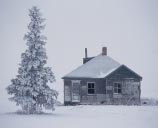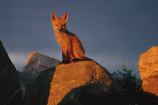
. . . . it's just
P R A I R I E
T O O
INTRODUCTION
Many people, even some who live on the prairies, see nothing but a flat, boring landscape. To those people the prairies are just a place to live and work or to pass through to get to somewhere else. Not so. The prairies are infinitely variable and therefore can be extremely interesting if we let ourselves see and experience them.
First of all we need to get out of the cities and off the main roads. Because of our very busy lives we tend to drive directly to and from instead of making the trip part of the enjoyment. We have a vast network of roads on the prairies, many of them little used backroads and trails leading to absolutely marvellous out-of-the-way places.
There is nothing on earth like the North American prairies. The colour and richness of both the earth and the sky, especially the clear air and the fabulous sunsets, can be seen nowhere else in the world. The real beauty of the prairie lies in the variety of landscapes and vegetation evident as we move from one area to another. Sometimes the land is rich and fertile, covered with bountiful crops; sometimes it is stark and dry, almost a semi-desert; while in other areas the land includes rolling hills often covered with forest or bush with beautiful, clear lakes to freshen the view and the mind.
In addition, the prairie is one of the most useful landscapes anywhere. The rich, fertile soil covering huge portions of the prairies has always been a great attraction to those who would "sow and reap". The original French explorers gave the land the name prairie which means meadow in French. Their first impression was of a vast treeless expanse - a sea of grass. My grandfather homesteaded east of Hanley, Saskatchewan, in the early 1900s and the Regina to Prince Albert Trail passed through his back pasture. His memory was of travellers on that trail regularly making camp beneath a tree by a slough at the edge of his property. Because of frequent prairie fires on the open grasslands, that tree was the only one along the entire trail.

The landscape has changed several times since then. There are many more trees on the bald prairie now but in other places large areas of bush have been cleared to create more farmland. Long rows of colourful grain elevators sprang up every few miles along a network of railway tracks, and small towns thrived beneath these sky piercing landmarks. The landscape came alive with farmyards and families every mile or so and country schools and churches every few miles.
More recently the landscape has changed quite drastically again. Farms are becoming bigger and therefore fewer. Retiring farmers often move to town or to the nearest city and many farm families no longer actually live on the farm, especially during the winter months. As a result there are many abandoned farmyards, small towns are dying, and urban areas are growing in population.
The tall "prairie sentinels" and the rail lines that once served them are disappearing at an alarming rate, replaced by a few huge inland terminals. On the positive side, some of the poor soil areas that never should have been broken in the first place are now being returned to pasture or grassland.
With this book, as with my first book ....it's just PRAIRIE, I have tried to capture some of the beauty of our wide open spaces and vast expanse of sky. Since I work best with light and colour, early morning and late afternoon are usually the best times for me to make photos. It's then that the grass is a richer green, the sky is a deeper blue, bright reds and golds are more intense, and contrasts and shadows are more defined. Occasionally I get lucky and just happen to come across the right scene under the right conditions, but other times it takes hours or days, sometimes years, to get the photograph I was looking for. Sometimes I have to return to the same place many times to get everything right. After all, you know what they say about the prairies, "If you don't like the weather, wait five minutes!" The light and the mood often change by the minute.

Good wildlife photos are often very difficult to get because the animal does not always co-operate and the lighting is usually not what I would use if I had a choice. As a result, it is frequently necessary to expose hundreds or even thousands of frames to get just one really good image. That is one of the main reasons for doing much of my wildlife photography in areas like National Parks where hunting is not allowed. The animals are not tame but at least they are not completely spooked by the mere glimpse of a human. Good wildlife photos are not generally a matter of chance. The photographer must go to where the animal is and either stalk it or be prepared to wait for long periods of time for it to come to him or her. Even then the photos are often nothing special, but the experience of being in that wild world, just for a little while, is usually worth all the effort.
We need to be more aware of our environment and our fellow inhabitants on this earth and we need to take better care of them. We must balance our wants and needs against the total health of the environment. After all, isn't the health of the environment what determines our quality of life? Perhaps if you like what you see in this book you can use it to become more aware of how much we have to lose if we don't stop running up a debt against our own future and the future of all the other species that share this planet with us.
I hope you can truly live in the photos I have chosen for this book - that you can feel the warmth of the summer sun and the harshness of the winter cold, and hear the call of the loon and the howl of the wolf. Enjoy.

BOOK JACKET
I have been asked many times over the last three or four years when I was going to publish another book. As in "....it's just PRAIRIE" I was determined to not use any "fillers" - each photo must stand on its own.
The photographs in this book are only a very few of the thousands I have made since my first book was published in 1996. As with most photographers I find that probably only about 1% of the images I make are good enough to satisfy me, and probably only about 10% of those are good enough to satisfy the general public. As a result we tend to amass thousands of transparencies that just don't quite make the grade.
I hope the photos I have chosen for this book do make the grade for you. Many of them are of every day scenes of life on the prairie, some are less common and a few are experienced only once in a lifetime. Some were very easy to get - some took a great deal of effort, but they all generate great memories in my mind. I hope they do the same for you; whether you grew up on the prairie and have lived here all your life or have only visited and enjoyed your stay.
If you have never been to the prairies maybe this book will encourage you to come and visit us. We are a friendly people and would love to see you. Have a great day.